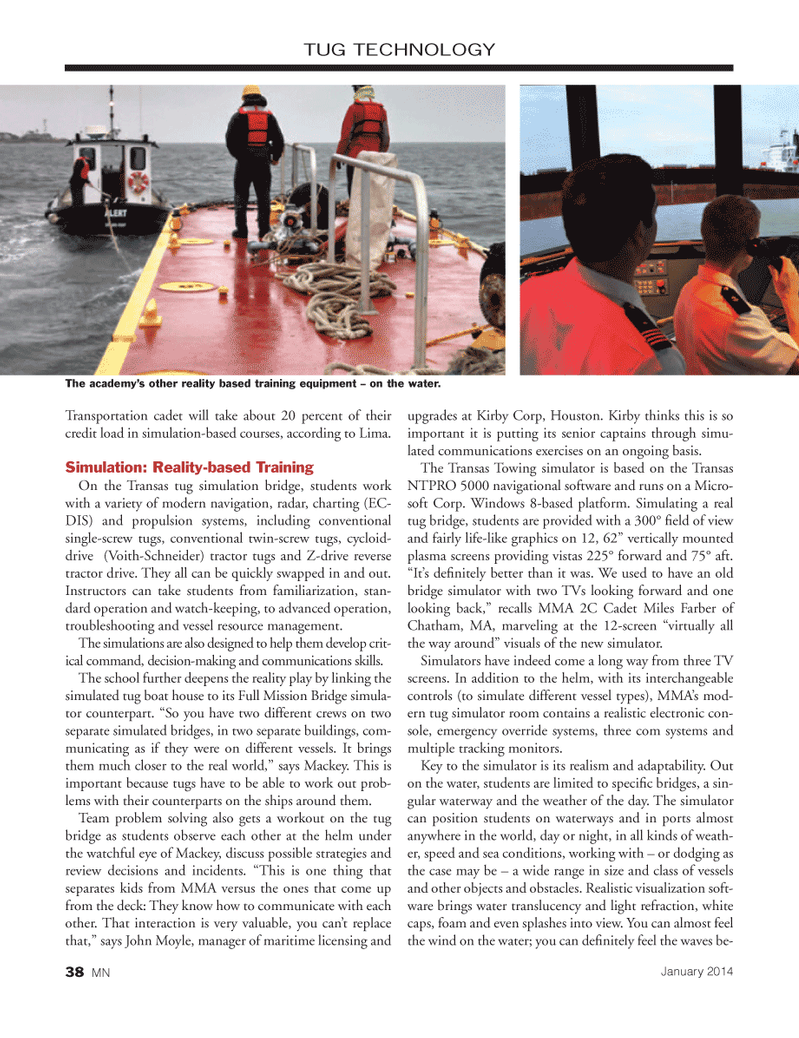
Page 38: of Marine News Magazine (January 2014)
Tug Boat Technology
Read this page in Pdf, Flash or Html5 edition of January 2014 Marine News Magazine
Transportation cadet will take about 20 percent of their credit load in simulation-based courses, according to Lima.
Simulation: Reality-based Training
On the Transas tug simulation bridge, students work with a variety of modern navigation, radar, charting (EC-
DIS) and propulsion systems, including conventional single-screw tugs, conventional twin-screw tugs, cycloid- drive (Voith-Schneider) tractor tugs and Z-drive reverse tractor drive. They all can be quickly swapped in and out.
Instructors can take students from familiarization, stan- dard operation and watch-keeping, to advanced operation, troubleshooting and vessel resource management.
The simulations are also designed to help them develop crit- ical command, decision-making and communications skills.
The school further deepens the reality play by linking the simulated tug boat house to its Full Mission Bridge simula- tor counterpart. “So you have two different crews on two separate simulated bridges, in two separate buildings, com- municating as if they were on different vessels. It brings them much closer to the real world,’’ says Mackey. This is important because tugs have to be able to work out prob- lems with their counterparts on the ships around them.
Team problem solving also gets a workout on the tug bridge as students observe each other at the helm under the watchful eye of Mackey, discuss possible strategies and review decisions and incidents. “This is one thing that separates kids from MMA versus the ones that come up from the deck: They know how to communicate with each other. That interaction is very valuable, you can’t replace that,” says John Moyle, manager of maritime licensing and upgrades at Kirby Corp, Houston. Kirby thinks this is so important it is putting its senior captains through simu- lated communications exercises on an ongoing basis.
The Transas Towing simulator is based on the Transas
NTPRO 5000 navigational software and runs on a Micro- soft Corp. Windows 8-based platform. Simulating a real tug bridge, students are provided with a 300° fi eld of view and fairly life-like graphics on 12, 62” vertically mounted plasma screens providing vistas 225° forward and 75° aft. “It’s defi nitely better than it was. We used to have an old bridge simulator with two TVs looking forward and one looking back,” recalls MMA 2C Cadet Miles Farber of
Chatham, MA, marveling at the 12-screen “virtually all the way around” visuals of the new simulator.
Simulators have indeed come a long way from three TV screens. In addition to the helm, with its interchangeable controls (to simulate different vessel types), MMA’s mod- ern tug simulator room contains a realistic electronic con- sole, emergency override systems, three com systems and multiple tracking monitors.
Key to the simulator is its realism and adaptability. Out on the water, students are limited to specifi c bridges, a sin- gular waterway and the weather of the day. The simulator can position students on waterways and in ports almost anywhere in the world, day or night, in all kinds of weath- er, speed and sea conditions, working with – or dodging as the case may be – a wide range in size and class of vessels and other objects and obstacles. Realistic visualization soft- ware brings water translucency and light refraction, white caps, foam and even splashes into view. You can almost feel the wind on the water; you can defi nitely feel the waves be-
TUG TECHNOLOGY
The academy’s other reality based training equipment – on the water.
January 2014 38 MN
MN JAN14 Layout 32-49.indd 38 12/20/2013 10:17:08 AM

 37
37

 39
39
